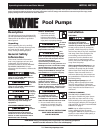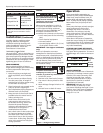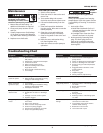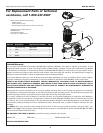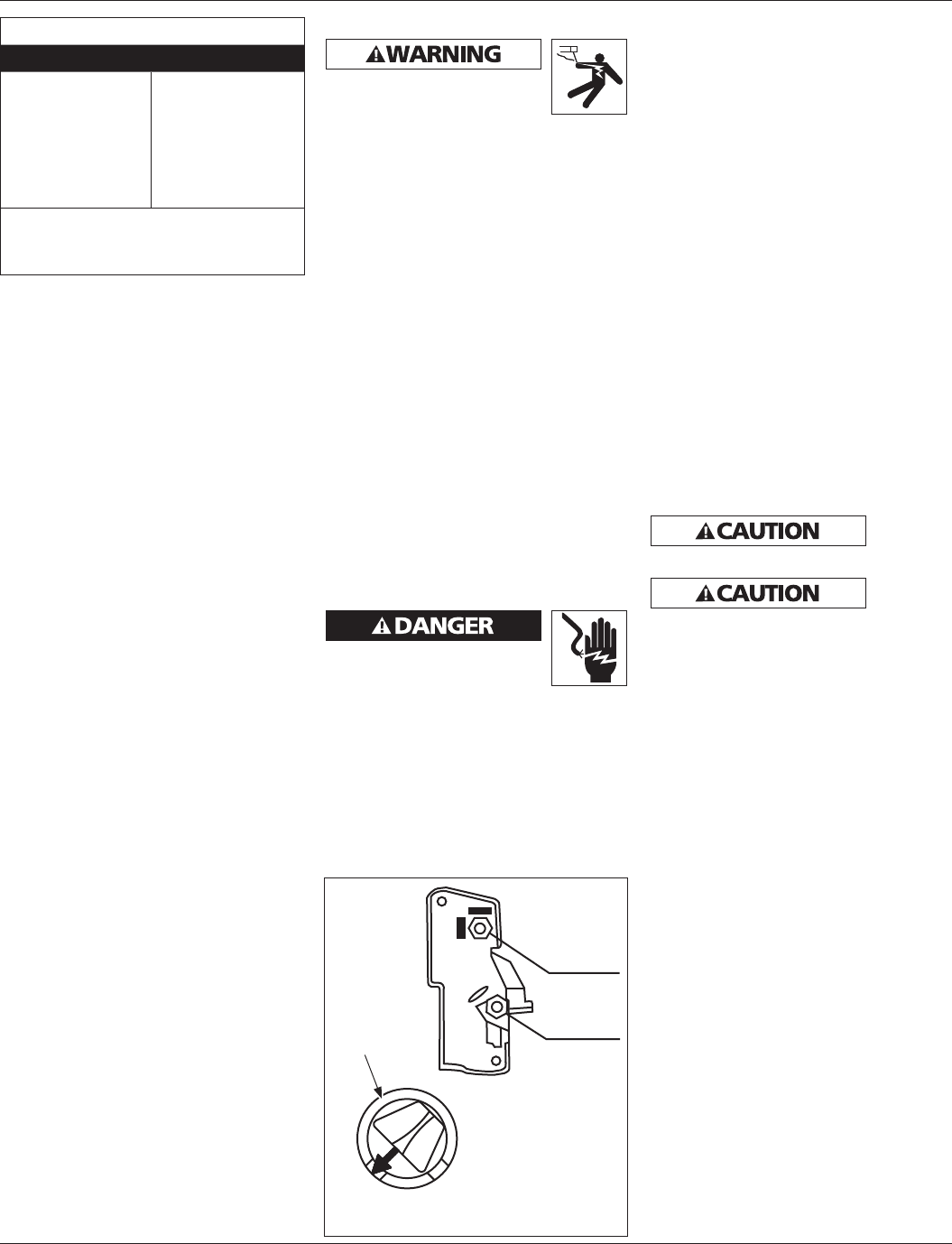
2
Operating Instructions and Parts Manual
www.waynepumps.com
Installation (Continued)
Consider climatic conditions when
applying adhesives. Atmospheric
conditions with high humidity will
make the adhesive action of certain
glues less effective. Follow the
manufacturer's instructions.
THREADED CONNECTIONS
Use only Teflon
®
tape or equivalent on
threaded plumbing connections. Other
pipe compounds may damage threads.
Do not use silicone or petroleum based
compounds. Do not overtighten. Hand
tightening plus 1/2 turn is sufficient.
PUMP PLUMBING
Suction pipe should be as large or
larger than discharge pipe. Avoid using
a suction pipe smaller than pump
connection.
1. Keep the piping as straight and
short as possible, and of suitable
size.
2. Do not connect an elbow directly
into the pump inlet. A length of
straight pipe will allow proper entry
of the water to the pump.
3. Slope horizontal runs upward to the
pump to prevent trapping air.
4. Use independent piping supports to
alleviate strain on the pump.
5. Keep as much of the suction line as
possible below the water level to
reduce priming time.
6. Install valves and unions in the
pump suction and return lines
to facilitate servicing. Valves will
throttle the pump discharge.
Valves are also essential for pump
maintenance if the system is
installed below deck level.
7. Use a check valve in the suction pipe
for inground pumps at or below
the water level if the suction lift is
more than 5 feet or the dry suction
is more than 10 feet long. Keep the
valve in the suction line fully open
during operation.
WIRING
All wiring must be performed
by a qualified electrician. The
pump must be installed in
compliance with all local codes and the
National Electrical Code.
When motor installation is within 5
ft. (1.5 m) of the pool’s interior walls,
a solid copper bonding conductor
(minimum size No. 8 AWG/8.4 mm
2
)
should be connected from the
accessible wire connector on the motor.
• to all metal parts of the swimming
pool
• to all electrical equipment
• to metal conduit
• to metal piping within 5 ft. (1.5 m)
of the pool’s interior walls
IMPORTANT: Use copper conductors
only.
Refer to information on motor
nameplate for electrical service data.
Install motors with a fused disconnect
switch or dedicated circuit breaker. Be
sure wire size is sufficient for pump
HP and distance from power source.
Install a ground fault circuit interrupter
for maximum safety.
Disconnect, tag, and lock
out power source before
attempting to install, service,
relocate, or perform any maintenance.
1. Switch OFF power.
2. Remove cover from back of motor.
3. The motor is factory wired for 230
volts.
4. Move Voltage Change Switch to 115
volts.
5. Reinstall cover to back of motor.
Operation
Prime pump before attempting to
operate. To prime pumps located above
water level, remove strainer cover, fill
strainer body with water then replace
cover. If pump and all piping is located
below water level, the pump will self
prime.
After pump has been primed, energize
motor and open all suction and
discharge line valves. If no flow is
observed in five minutes, stop the
motor and reprime. If the pump fails
to operate, check for air leaks. Refer to
troubleshooting section.
After about 10 minutes of operation,
check the return fittings for air bubbles.
A continuous flow of air indicates leaks
in the suction line. Locate and correct
any leaks immediately.
CONTROLLING PUMP DISCHARGE
Keep the gate valve in the suction line
fully open during operation. To control
the discharge, use a valve in the return
line.
Do not
retighten
strainer Ring-lok during operation.
Do not
operate
pump with closed suction or discharge
valve.
WATER CHEMISTRY
Proper and consistent use of chemicals
is necessary to manage a water system.
Chlorine is the most commonly used
chemical to provide clean, sanitary
water. Daily administration of dry or
liquid chlorine (calcium or sodium
hypochlorite) is essential.
IMPORTANT: Maintain the correct
level of acidity or alkalinity of the
pool water. Readings above pH 7.0 are
alkaline. A pH 7.0 is neutral. Readings
below pH 7.0 are acidic. A desirable
range is 7.2 to 7.4.
RECOMMENDED ADHESIVES*
PVC - PVC Joint PVC - ABS Joint
Uni-Weld
Pool-Tite 2000
Uni-Weld
Pool-Tite 2000
Suregard Flex 20
Suregard Weld
All No. 5
IPS Weld-On 705 IPS Weld-On 794
*
These recommendations are examples
only and are not intended to restrict
brands
Line
Line
Voltage
Change
Switch
Figure 1 - Voltage Change Switch
Connections
115 230
Volts



